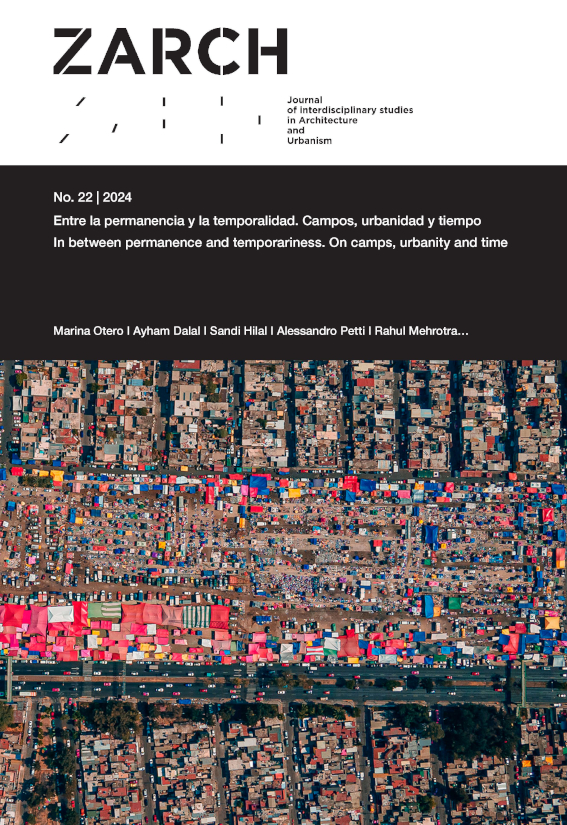Integrate without confining. UNHCR's thorny challenge to humanitarian and architecture aid
DOI:
https://doi.org/10.26754/ojs_zarch/zarch.2024229878Keywords:
UNHCR, Refugees, Refugee camps, Camp alternative policy, Urban integration, Humanitarian architectureAbstract
Since its founding in 1950, the United Nations High Commissioner for Refugees (UNHCR) has led the international policy of hosting refugees and displaced persons, using refugee camps as the main physical protection strategy. Although this option has solved and does solve reception emergencies, it tends to become entrenched over time and fails to provide feasible alternatives for subsistence and political autonomy, which has led those hosted to live in dependence on humanitarian aid, undocumented status, and hopelessness, contrary to expectations. In response, in 2014 UNHCR adopted the Camp Alternative Policy, which focuses on permanently hosting refugees in consolidated settlements to improve their inclusion and quality of life. Beyond the meager results obtained so far with this new policy, a critical reflection is presented on the social and spatial implications of an approach to the catch that questions how aid and humanitarian architecture have been understood, generating unprecedented challenges in design and management. Despite its implementation difficulties, this shift in strategy makes several timely proposals which, in our professional and academic understanding, are not being given the attention they deserve.
Downloads
References
ACNUR, «¿Cómo es el día a día en un campamento de refugiados?», eacnur, 9/10/2018. https://eacnur.org/es/blog/dia-a-dia-campamento-refugiados-tc_alt45664n_o_pstn_o_pst
ACNUR, Convención sobre el Estatuto de los Refugiados, 1951. https://www.acnur.org/media/convencion-sobre-el-estatuto-de-los-refugiados-de-1951
ACNUR, Datos básicos. 2023. https://www.acnur.org/es-es/datos-basicos
ACNUR, Política de Alternativa a los Campamentos. 2014. http://www.acnur.org/fileadmin/Documentos/BDL/2015/9905.pdf?file=fileadmin/Documentos/BDL/2015/9905
ACNUR, Política sobre la Protección de los Refugiados y las Soluciones en Zonas Urbanas. 2009. https://www.acnur.org/media/politica-sobre-la-proteccion-de-los-refugiados-y-las-soluciones-en-zonas-urbanas
ACNUR, Protocolo sobre el estatuto de los refugiados. 1957. https://www.acnur.org/media/protocolo-sobre-el-estatuto-de-los-refugiados
Asociación Esfera. Manual Esfera: Carta Humanitaria y normas mínimas para la respuesta humanitaria, cuarta edición, Ginebra, Suiza, 2018. www.spherestandards.org/handbook
Betts, Alexander. The Wealth of Refugees: How Displaced People Can Build Economies. Oxford: Oxford University Press, 2021.
Bravo Barahona, Isabel, Políticas de ACNUR en materia de habitabilidad: del refugiado en campamento a la integración urbana: 1950-2019. Tesis doctoral, Universidad de Alcalá (2021).
CEA[R], «El derecho de asilo más amenazado que nunca en el 75 aniversario de la Declaración Universal de los Derechos Humanos.» Madrid: Comisión Española de Ayuda al Refugiado, web, dic. 7 (2023) https://www.cear.es/derecho-de-asilo-75-declaracion-derechos-humanos/
Corrales, Bosco, «Migración y refugio: una reflexión interdisciplinar». SCIO. Revista de Filosofía, nº 19 (2021). http://hdl.handle.net/20.500.12466/1748
d’Albis, Hippolyte et al. «Macroeconomic evidence suggests that asylum seekers are not a ‘burden’ for Western European countries», Sciences Advances, vol. 4, nº 6. (2018). https://doi.org/10.1126/sciadv.aaq0883
Goycoolea, Roberto y Paz Núñez, «De ‘La vivienda es mi derecho’ a las ‘Ciudades armoniosas’. La nueva comprensión del espacio habitable de UN-HABITAT.» Sociedad y Utopía, nº 34 (2009): 217-230. http://hdl.handle.net/10017/29858, 2009
Günter, Nooke, Christiane Kraus & Nikolaus Wolf, eds., Cities, not Camps. The contribution of planned cities to development and migration policies. Zurich: InnoVatio Publishing. 2021. https://static1.squarespace.com/static/5d5488a97f30dd0001a098eb/t/62d16bc8d2144715d0e2d694/1657891785221/Cities_No_Camps_Web_Book.pdf
Knudsen, Are J. y Kjersti Berg, eds. Continental Encampment: Genealogies of Humanitarian Containment in the Middle East and Europe. New York: Berghahn. 2023
Neto, María C., Territórios indefinidos no dilema da acção humanitária. Tesis doctoral. Universidad de Alcalá, 2022.
Sanderson, David, Humanitarian response in urban contexts. London: Humanitarian Policy Group. 2021. GPR-12-2019-001-244-web4_FINAL.pdf
Scott-Smith, Tom, «Places for People. Architecture, Building and Humanitarian Innovation», Journal of Humanitarian Affairs, Vol. 1, Issue 3 (2020). https://doi.org/10.7227/JHA.021
Trautmann, Micah, «The wrong of refugee containment», The Southern Journal of Philosophy, 61 (2023). https://doi.org/10.1111/sjp.12546
Tuzcu, Nil. «An inquiry into socio-spatial segregation: case study of Syrian refugees in a Turkish border city», U. of Cambridge: DRAN, Displacement Research & Action Network (2015) https://static1.squarespace.com/static/545c070ce4b039195ee41975/t/56a111ef9cadb64cb226c091/1453396464969/Socio-spatial%2Bsegregations.pdf
UNHCR, Outcomes of the Global Refugee Forum. 2019. https://globalcompactrefugees.org/sites/default/files/2020-08/Outcome%20document%202019%20GRF.pdf
UNHCR, Mid-Year Trends 2023. UNHCR Global Shelter Cluster (2023) https://www.unhcr.org/mid-year-trends-report-2023
UNHCR, Shelter Design Catalogue, Geneva: United Nations High Commissioner for Refugees. 2016. https://cms.emergency.unhcr.org/documents/11982/57181/Shelter+Design+Catalogue+January+2016/a891fdb2-4ef9-42d9-bf0f-c12002b3652e, 2016.
UNHCR, The LIS Global Indicators, UNHCR. Livelihoods Monitoring System (2022). https://lis.unhcr.org/data
Wagemann, Elizabeth, «From Shelter to Home: Flexibility in Post-Disaster Accommodation», Apollo, U. of Cambridge, August 27, 2017. https://doi.org/10.17863/CAM.43234


